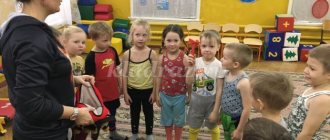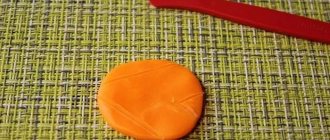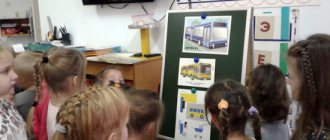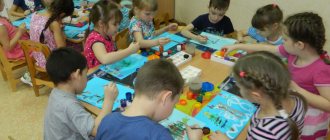The importance of music classes in the senior group of preschool educational institutions
Music classes are conducted throughout all years of preschool education. Music is an extraordinary means that teaches us to perceive the world around us through sound aesthetics and emotionally-filled works. The classes provided give children joy, a positive charge of energy, a good mood, and develop a sense of rhythm and melody.
Scientifically proven fact. Music lessons contribute to the development of a child’s intellectual abilities.
In the older group, children need to be actively introduced to various musical instruments and taught the basics of playing them. Musical activities of a rhythmic nature, such as rhythm, movements to music, and various musical performances, are also welcome. It is necessary to show preschoolers how to perceive the world through musical means.
Music lessons develop aesthetic taste and intellectual abilities
The goals of music classes in the senior group may be the following:
- developing the creative abilities of preschoolers with the help of music;
- increasing interest in music;
- development of musical ear, rhythm, plasticity;
- education of a harmoniously developed personality.
The tasks vary depending on the type of activity, but the main ones can be identified:
- developing interest in musical activities;
- development of abilities and skills in a certain area (vocals, playing a musical instrument, rhythm);
- formation of musical culture.
Techniques relevant for the older group
- Gaming techniques. Introduction to the art of music through play creates optimal conditions for instilling a love of beauty and developing the creative abilities of students. unexpected appearance of toys,
- improvisation games,
- educational games,
- creating a game situation.
Since play is the leading activity in preschool age, gaming techniques will be relevant for pupils of all groups of preschool educational institutions.
Types of music classes
Music classes vary in content. It could be:
- A typical music lesson is a traditional music lesson that includes performing, listening and mastering a piece of music. The structure of this type of lesson can be different. For example, you can start by listening to some famous piece or, conversely, first the children sing a learned song in chorus.
- A dominant music lesson is a type of lesson whose emphasis is on something specific. For example, learning a musical instrument, mastering rhythmic techniques, developing hearing, etc.
- An integrated music activity is characterized by the use of various activities together with music. For example, a combination of music and artistic creativity (drawing, modeling, dance, theater activities), music and reading a literary work, music and architecture, music and sports. This kind of classes is more complex in its structure, so it is recommended to start introducing them from the middle group of preschool educational institutions. They are held no more than once a month.
- A thematic lesson highlights a specific topic that unites all types of children’s musical activities, on the study of which the entire course of the lesson is based. For example, the theme “Seasons” or “Fairy Tales in Music”, etc.
In the older group, children actively learn to play musical instruments
Depending on the number of students participating in the lesson, there are:
- individual sessions;
- music lessons in subgroups;
- group music lessons.
How to conduct a music lesson in a senior group
To conduct a lesson competently, you need to select suitable topics, outline a plan, and take into account relevance.
Preparation for class
A stereo system, projector, laptop, and various musical instruments can be used as preparatory equipment. Before the main part of the lesson, the motivating part can be done in the form of looking at pictures on a certain topic, reading a fairy tale or poem related to a piece of music, or discussion. For example, in a music lesson on the fairy tale “Teremok”, you can start the lesson by repeating the fairy tale (reading or discussing), and then move on to the main part: voicing the characters of the fairy tale using musical instruments.
Topic index
For the older group, the following topics for classes may be relevant:
- Seasons: “Musical colors of spring”, “Music of autumn”, “Music of spring”, “The Tale of a Snowflake”;
- Music and fairy tales: “Teremok”, “The Miraculous Transformation of Fedora”;
- Introduction to musical instruments and elements of musical literacy: “Merry pipe”, “Get to know the notes”, “In the world of musical instruments”;
- Aimed at cultivating morality: “Good and evil in music”, “Polite words”, “Image of a mother”, “Let’s return the mood to music”;
- Plot: “Fair”, “Trip out of town”, “Music store”, “Merry musicians”;
- Educational: “Music and Sports”, “Travel to India”, “Travel to Africa”, “Travel during the War Years”, “Space”.
You can come up with many different variations of activities on the autumn theme.
Fragment of a summary of a musical lesson based on the fairy tale “Teremok” in the senior group (author Alevtina Glotova)
In the lesson, fairy tale characters will be voiced with musical instruments.
The teacher begins the lesson with a greeting and an introductory word:
- Guys, do you like fairy tales? I also really love fairy tales.
- What fairy tales do you know? (Children's answers).
- Listen to the riddle and guess what kind of fairy tale it is? The fox found a home for herself, the mouse was kind, and in that house, in the end, there were many tenants.
- What fairy tale is this riddle talking about? That's right, this is the Russian folk tale "Teremok". And today I invite you to voice this tale with musical instruments.
Next, all the characters in the fairy tale are analyzed and a suitable musical instrument is selected for each:
- Little mouse, what musical instrument can we use to represent a mouse? Of course, with a rattle - sprinkles;
- Frog-wah - with musical hammers;
- Runaway bunny - with wooden spoons;
- Little fox-sister - metallophone;
- Wolf - gray tail - rattles, tambourines;
- Bear - drum.
Next, the roles are distributed among the children and musical instruments are distributed. The teacher begins to read the fairy tale, and the children voice the characters with musical instruments when they appear.
- There is a teremok in the field - a teremok, It is not low, not high, not high. Like a mouse running across a field, a field, stopped at the door, ringing the bell.
- The mouse rings the bell, but the door to the little house does not open. The teacher draws the children's attention to the fact that the tower has a note that says that the tower is magical.
- Guys, the tower is not simple, but magical. To enter it, you need to complete a task. Look, here are the cards with diagrams on them. We told you that a mouse can be represented by rattles - sprinkles. The mouse must find its diagram and play what is written there.
- Well done, mouse, why did you choose this scheme? Of course, there is a rattle on it.
- The mouse plays according to the scheme, the door to the little house opens.
- Well done Mouse, you completed the task, go into the little house.
The mouse and the frog are voiced. Next comes a physical training session:
- Like our neighbor (the children turn to each other and bow), the conversation was fun. Ghouls in the gusli (squat, pretend to play the gusli), Ducks in the pipes (stand up, bend back, turn from side to side), Sheep in the Donets (clap their hands, pretend to play the tambourine), Cockroaches in the drums (march, pretend to play on the drum). They play very happily and make each other laugh.
- Well done! Meanwhile, the fairy tale continues.
Further in the text of the tale the fox, wolf and bear are voiced.
Preschoolers will be interested in voicing characters from an already familiar fairy tale.
After finishing reading, the teacher says:
- Was it an interesting fairy tale? Of course, interesting, what new did you learn today?
- All fairy tale heroes can be depicted with musical instruments. I want to give you a treble clef so that music will always sound for you. Now let’s say goodbye and head back to the group.
Quote from: https://www.maam.ru/detskijsad/zanjatie-po-muzykalnomu-vospitaniyu-po-skazke-teremok-ozvuchivanie-personazhei-skazki-muzykalnymi-instrumentami-dlja-5–6-let.html
Video: musical fairy tale “Teremok” in kindergarten
Table: notes of music classes conducted in the senior group of preschool educational institutions
| Author and title of the abstract | Description of material |
| “The Magic Umbrella”, E.N. Kozlova | Scenario for autumn entertainment in the senior group. Autumn comes to the children for the holiday with a magic umbrella that helps create all sorts of miracles. |
| “The Adventures of the Magic Clock”, I.V. Fedorov | New Year's musical party with the participation of fairy tale heroes: Pinocchio, Malvina, Baba Yaga, Koschey the Immortal. |
| “Space”, P. Mazurenko | A musical lesson in a senior group on the theme of space using musical works dedicated to it. |
| “Sounds of spring in nature and music”, E.N. Moreva | In the lesson, using riddles, Russian folk songs, works by M.I. Glinka talks about how nature, the sounds of spring, and birdsong are reflected in music. |
| “Native Land”, N.G. Korshunova | Educational and musical entertainment is aimed at improving children's knowledge about the Urals: its nature, lakes, minerals, and precious stones. |
| “Summer natural phenomena”, N.N. Mironova | The literary and musical lounge is aimed at strengthening children's ideas about summer natural phenomena. |
| "Music Store", M.A. Krasnova | An open lesson deepens children's knowledge about the types of musical instruments and their diversity. |
| “Music Box”, T.L. Soldatova | An open music lesson shapes children's ideas about modes in music, teaches them to listen to musical works and develops creative imagination. |
Video: music lesson in the senior group
Music-themed music lesson for children of the senior group Topic: “Mom is the main word!”
Transcript
1 Music-themed music lesson for children of the senior group Topic: “Mom is the main word!” Goal: development of children’s musicality, the ability to emotionally perceive music. Objectives: expand ideas about holidays; develop the ability to characterize music and situations; continue to improve children’s artistic and speech skills when reading poems and performing songs (emotionality, naturalness, the ability to convey their attitude to the content with intonation, gesture, and facial expressions); evoke a vivid emotional response when perceiving music of a different nature; cultivate a caring and sensitive attitude towards the person closest to you. Children come to the music, stand in a circle, and say hello. Musical director: Guys, I know that you like to solve riddles, so Kira has prepared a riddle poem for you. (child reads a poem) Kira: Who came to me in the morning? Who said: “It’s time to get up?” Who has already cooked the porridge? Who poured tea into my cup? Who as a child loves laughter? Who is the best in the world? Children: Mom! Musical director: Guys, why did Kira prepare a riddle for you about your mother? Children: Because Mother's Day is coming soon. Musical director: Guys, in Russia Mother’s Day is celebrated on the last Sunday of November. What do people do on this day? (Congratulations to moms). How can you congratulate? Sing a song, read a poem, make a postcard or craft with your own hands. They also say kind, pleasant words to mothers and give compliments. Let us also praise our mother and play the game “Continue the Sentence” Game “Continue the Sentence”
2 (music director begins, children continue) - My mother is the best - My mother knows what to do best - My mother is happy when I - My mother is upset when I - I like it when my mother - I affectionately call my mother Children perform a song “The little dawns are more beautiful” Musical director: Well done, let’s sit on the chairs. (Children sit in a semicircle) Musical director: Listen to the story I want to tell you. A long time ago, more than five hundred years ago, in the distant country of Italy, there lived a boy with the beautiful name Raphael. The boy Raphael had real talent as an artist. One day he told his father: “I want to learn how to paint so that in my paintings there will be blue skies and beautiful faces of people. Let people look at my paintings and forget about everything in the world.” Little Raphael's dream came true. He became the greatest artist. Raphael Santion painted beautiful paintings known all over the world. He dedicated many of them to women. And his paintings depicting a woman-mother are especially beautiful. The painting “The Sistine Madonna” is considered one of his best works. (shows a slide) Look, this is a woman with a child. The artist depicted the mother woman as a goddess. Look at the Madonna's face? (beautiful, kind, gentle, calm, thoughtful) What do you think she is thinking about? (About the fate of your child). But the woman-mother was praised not only by artists, but also by composers. How does the composer express his feelings? (With the help of music). Let's listen to the piece, a musical portrait of a woman-mother. This is a song performed by an Italian children's choir. “Ave Maria” by F. Schubert sounds. Musical director: This beautiful music was written by the Austrian composer Franz Schubert. What is the nature of the music? (The music is tender, calm, pure, beautiful) Schubert, just like Raphael, admires the woman-mother. “Ave” means “Glory.” “Mary” is the image of a mother. “Ave Maria” - the singer sings, i.e. "Glory to the Mother!" Glory to her love, her care, her kind heart!
3 Musical director: Now I’ll ask everyone to stand in a circle (children stand in a circle) and let’s play the game “Pass the Heart.” I’ll ask you to tell about your mothers. What are they? What kind words about your mother do you know? Standing in a circle, taking turns, we will pass the heart to the neighbor on the right side, on whom the music stops, he must say an affectionate word about his mother (For example: affectionate, gentle, kind, good, beautiful, loving, cheerful, caring, and so on.) Musical director: Well done! All children completed the task. Today we played well, but we haven’t danced yet. I’ll ask everyone to stand in pairs and let’s dance together! Children perform the dance “Turn Around” by Evtodieva Musical director: Children, I know that you all have kind, beautiful and affectionate mothers, but they are all different. Arisha's mother looks like a sorceress, listen to her poem: Arisha: Mom is like a sorceress if she smiles Every wish I have comes true A kiss from my mother - the bad is forgotten A new day, a cheerful day Begins right away. Musical director: But Lena compares her mother to the warm sun. Lena: How this happens, I myself don’t understand. That the sun is in the sky, then my mother is in the house. The sun will suddenly hide behind a cloud. Everything will become empty and sad around. My mother will leave for a while. I will become so sad. My dear one will return home and I will become cheerful again. I play, I laugh, I tumble, I sing. I love my dear dove!
4 Musical director: Also listen to the poem “The Heart of a Mother” They will tell it.. (children come out and recite the poem) The Heart of a Mother... Olga Grazhdantseva 1st child: The heart of every mother A mesh of scars Every cry of a child is a tiny scar Broken knees, Blood from a finger - wreaths Without such marks, mothers have no hearts. 2nd child: Cough and sore throat, Fever in daughter, son. Chickenpox spots, sleepless nights. Dentist's office. Fear and tears again. Mother holds it in her heart. 3rd child remembers everything in full: First grievances. - Small in appearance Only the mother’s heart feels their pain With each new scar The mother’s heart is hotter - “Don’t be afraid, baby, I’m always with you.” 4th child: The suns grow up, Quarrel, get sick, Understand the turns of adult life But mothers are still the same Collecting scars Imprints of pain Sharp knives 5th child: This connection, like a miracle, Stays everywhere Mom will take away half of the pain If she can do more, If only it lasts longer She had enough strength... I wish I knew in advance
5 6th child: If necessary, Mom will be there You need to take a deep breath, you need to be silent The heart of every mother A mesh of scars But without these scars the heart does not beat Musical director: Now find out by the melody what kind of song this is? (performs a fragment of the work) That's right. This is the song “Baby Mammoth” by Vladimir Yakovlevich Shainsky. Watching the cartoon “Mom for Baby Mammoth” Musical director: Remember what other songs about mom we know? Standing near the chairs, we will sing the familiar song “Mama is a ray of sunshine.” Children perform a song Musical director: Now come out, all the guys, to dance “Merry Dance” by Evtodieva Musical director: What do you remember most? What did we do? What new did you learn? What songs did you sing, what dance did you perform, what did you listen to, what game did you play? For the fact that you sang, danced, and recited poems well, I will give you hearts as a souvenir as a symbol of love and kindness (the music director gives out hearts to the children)
Musical and entertaining leisure time for older preschoolers
Leisure plays an important role in children's lives. Classes of this type are held in a relaxed atmosphere and develop children’s creativity and independence. Parents and children from other groups can be present and participate in the process. Children receive a great boost of energy when they use sports games and competitions that involve active movements.
Musical entertainment can take place in a relaxed atmosphere, or it can involve active forms of activity.
An important point is the preparation of mass musical and entertainment leisure events, during which costumes are prepared, rehearsals are held, dances and songs are learned.
Table: example of a scenario for sports and musical leisure (fragment)
| Author | Ostrogina N., teacher, secondary school No. 1416, structural unit 4 (d/s) |
| Name | "Funny traffic light" |
| Progress of the event | Heroes: presenter, Winnie the Pooh, Piglet.
|
| Quote from: https://www.maam.ru/detskijsad/sportivno-muzykalnyi-dosug-veselyi-svetofor-starshaja-grupa.html | |
Table: example of a scenario for musical-ecological leisure (fragment)
| Author | Milova O., teacher, Lyceum No. 1564, Moscow |
| Name | "Sea, sea, ocean" |
| Progress of the event |
|
| Quote from: https://www.maam.ru/detskijsad/yekologicheskii-dosug-more-more-okean-starshaja-grupa.html | |
Video: musical leisure in the senior group
Long-term planning of music classes in the senior group
Long-term plans are usually drawn up by the music director in kindergarten before the start of the school year. The plan specifies the period, tasks, repertoire used and techniques that will be appropriate in the lesson.
Table: example of long-term planning of music classes in a senior group (fragment)
| Author | Stroganova A.M., music director, MDOU Kindergarten “Ogonyok”, p. Ust-Kachka, Perm region | ||
| Month | Kind of activity | Program content | Repertoire |
| September | Musical and rhythmic movements:
|
|
|
| Perception of musical works. |
|
| |
Singing:
|
|
| |
| Playing musical instruments. | Teach children to perform simple songs on children's musical instruments (rattles, drums). | “Rain” A. Kholminov | |
| October | Musical and rhythmic movements:
|
|
|
| Listening (perception of musical works). |
|
| |
Singing:
|
|
| |
| Playing musical instruments. | Perform short songs on children's musical instruments individually and in small groups. |
| |
| November | Musical and rhythmic movements:
|
|
|
| Listening (perception of musical works). | Perceive the clear rhythm of the march, expressive accents, listen to various dynamic shades. | “March” by S. Prokofiev from the opera “The Love for Three Oranges”. | |
Singing:
|
|
| |
| Playing musical instruments. | Teach children to play in an ensemble clearly, harmoniously, and maintain the overall dynamics. | “Joke” by A. Selivanov. | |
In the older group, children need music lessons. They develop their hearing, accustom them to beauty, and form a musical culture. Musical and entertaining leisure gives children an emotional charge and reveals their creative abilities.
Summary of a musical thematic lesson for the senior group of the preschool educational institution “Wooden sounds”
"Wooden Sounds"
Summary of a music-themed lesson for the senior group of preschool educational institutions
Author: Gushchina T.N.
musical director
MBDOU kindergarten No. 52
Ulyanovsk
Target:
attract children's attention to the richness and diversity of the world of sounds,
produced by wooden objects and musical instruments;
develop the subtlety and sensitivity of timbre hearing, imagination and ingenuity in sound creation, imagination.
Musical instruments:
spoons, rattles, rubles, xylophones, claves.
Benefits:
boxes, wooden sticks, toys, wooden boxes, beads.
Progress of the lesson
Musical director:
Hello children! Come in, sit down.
(includes audio recording with noise)
- Do you hear, guys? What is this?
Children:
The sound of the wind, the crow of a rooster, the sound of train wheels...
Musical director:
All these are sounds that surround us. There are a lot of them and they are so different. And every sound can be music. You just have to try to hear it... What happens if all the sounds suddenly disappear?
Children:
There will be silence...it will become boring, uninteresting, sad...
Musical director:
I agree with you guys.
Life would be terribly boring, If life were silent... - How wonderful it is to hear sound: The sound of rain and the beating of the heart!
We scream, laugh, breathe, We hear words and thoughts, We even hear silence... - How a cat walks on the roof, How mice rustle behind the wall, Wolves howl at the moon.
A world without sounds would be sad
Gray, boring and “tasteless”.
A. Usachev “Zvukarik”
And today I invite you to listen to unusual stories. And they will be told by wooden sounds that live everywhere. Take a look around our hall and find objects made of wood... Name them.
Children:
Table, chairs, door, piano, window frames...
Musical director:
Let's go up to these wooden objects, knock with a stick and listen to the sounds they make.
(they approach the door and knock on it)
Musical director:
Which sound?
Children:
Dull, dry...
(also examine other wooden objects)
Musical director:
You will notice that the “voices” of these wooden objects are different. What else can you knock on?
Children:
Hand, pencil, metal stick...
(The music director brings the children to a table with small wooden objects)
Musical director:
How many objects in our life can be made of wood... Now try to guess what these sounds are and when you can hear them
(includes audio recordings: 1. “A woodcutter cuts down a tree”, 2. “Knock on the door”, 3. “Knock of a woodpecker”)
-And all these are wooden sounds! And how different they are - dry, clicking, crackling.
Why do you think sound quality depends?
Children:
From the size of the item.
Musical director:
Yes, and also on the method of sound production, on what we knock with and on the force of the blow.
Now repeat after me:
What is the wooden sound?
It's clattery and dry.
Warm and crispy
Quiet and loud
— Guys, many ordinary wooden sounds over time moved into wooden musical instruments: spoons, rubles, boxes, claves.
Here are spoons, for example. (Slide on screen)
They ate it with spoons, but now it is a percussion musical instrument. There are entire ensembles of spooners! (slide on screen)
Or the ruble served as a washboard. Your great-great-grandmothers once washed clothes on such boards. (Slide on screen)
But here are the beaters, the boxes - which became boxes.
The box is a knocker
For all sorts of things
And if you shake her,
You will hear “knock-knock-knock.”
-Here are the boxes! Let's see if this is really the case.
(buttons are pre-arranged in 1 box, the music director invites the children to shake it)
-Do you hear the sound? What is he like?...
-Let's try to put, for example, carnations and beads in two other boxes.
(shaking) And now what sound do you hear?... Such seemingly identical boxes at first glance make different sounds!
-Let's fantasize: let's try to imagine a conversation between these boxes. What can they talk about?
Children:
Maybe about the weather...or about outfits...
Musical director:
Guys, the most amazing transformation happened with wooden logs - they became the keys of an elegant and beautiful xylophone.
(slide on screen)
-What sound does this instrument have?
Children:
Melodious, gentle...
(audio recording plays)
Musical director:
Sounds beautiful, doesn't it? I think you can't wait to play these wonderful musical instruments yourself. Then come up, choose one instrument, and together we will try to perform the Russian dance “Oh you, canopy.” You can play and dance!
The dance song “Oh you, canopy” sounds
Musical director:
How many different wooden sounds we have now heard in one orchestra! Amazing! Now put down the musical instruments and...
Chick-chick-chickalochka, let's play with sticks?...
A game for the development of speech, attention, feelings
(children tap the rhythm with sticks)
Little feet, have you walked? We walked, we walked. Legs, legs, were you running? We ran, we ran, Legs, legs, did you dance? We danced, we danced, Legs, legs, are you tired? We're tired, we're tired. And they all started again.
Musical director:
Let's now lay out a beautiful pattern on the floor from these wooden sticks...
I think it turned out well! Guys, now listen to my wooden pattern
(The music director plays the xylophone)
- Which of you wants to come up with and play your own pattern?
Well done! You really made some unique patterns. Our lesson has come to an end, and I propose to finish it with a puppet dance in a table theater!
(children take wooden dolls)
The play “Kamarinskaya” by P.I. Tchaikovsky is playing
Musical director:
Guys, did you enjoy today's lesson?...
What did we meet today, what did we listen to? (Wood sounds)
I would like for you to continue getting acquainted with the sounds made by wooden objects when you come home. Share your impressions of what you heard at the next lesson. Goodbye!





